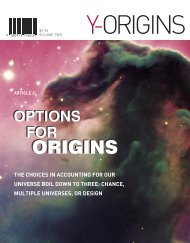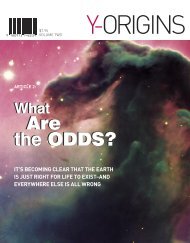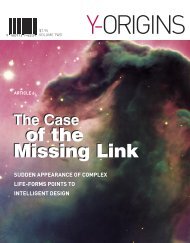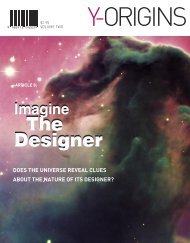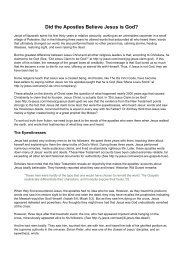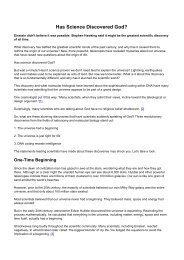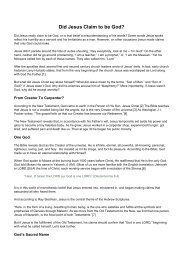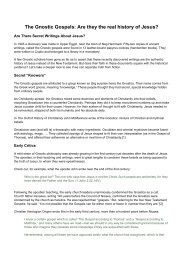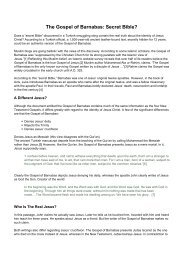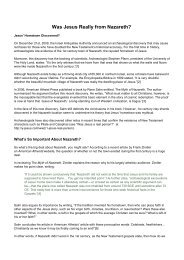Human_enigma7
You also want an ePaper? Increase the reach of your titles
YUMPU automatically turns print PDFs into web optimized ePapers that Google loves.
$7.95<br />
VOLUME TWO<br />
Y-ORIGINS<br />
ARTICLE 7:<br />
The<br />
<strong>Human</strong><br />
Enigma<br />
SCIENTIFIC EVIDENCE INDICATES HUMAN BEINGS ARE AN<br />
UNIQUE SPECIES THAT IS FAR SUPERIOR TO ANY SPECIES<br />
EXISTING TODAY OR IN THE PAST
INSTRUCTIONS<br />
To view the layout and graphics, click on the Facing icon on the<br />
right side of your bottom tool bar in your Acrobat Reader © file. Try viewing at 75%.<br />
To read the article, click on the Single Page icon on the bottom right of your<br />
Acrobat Reader © file.<br />
To enlarge the print for easier viewing, click on the “+” by the<br />
magnifcation percentage in the middle of the tool bar at the top of the page.<br />
To move from one page to another, use your side scroll bar or click on the<br />
left or right arrow in the bottom tool bar.<br />
CLICK HERE to see other articles from Y-Jesus Magazine at www.y-zine.com<br />
Chief Editor: Larry Chapman<br />
Project Coordinator: Helmut Teichert<br />
Editorial Director: Rick James<br />
Design: Hydragraphik ® Studio ( www.hydragraphik.com )<br />
Sun Mountain Productions<br />
Article Editors: Rick James, Eric Stanford<br />
Copy Editor: Eric Stanford<br />
Writers: Larry Chapman, Rick James, Eric Stanford<br />
Y-ZINE<br />
PO Box 6017<br />
Great Falls, MT 59405<br />
Copyright 2006 by Bright Media Foundation and B & L Publications. All rights reserved.<br />
ISBN 0-9717422-3-5<br />
2 • Y-JESUS
The <strong>Human</strong> Enigma<br />
Click on the e-article title for contents<br />
SCIENTIFIC EVIDENCE INDICATES HUMAN BEINGS<br />
ARE A UNIQUE SPECIES THAT IS FAR SUPERIOR TO<br />
ANY SPECIES EXISTING TODAYOR IN THE PAST Page 6<br />
LOOK AT A HUMAN BEING Page 6<br />
SPEAKING OF SPEAKING Page 8<br />
UNQUELY HUMAN? Page 8<br />
ONE HUMAN ANCESTOR Page 10<br />
THREE POUNDS OF LUMPY GRAY AMAZEMENT Page 10<br />
THE MYSTERY OF CONSCIOUSNESS Page 11<br />
DIFFERENT BY DESIGN? Page 12<br />
ENDNOTES Page 12<br />
IMPRINTS OF DESIGN ON THE SOUL Page 13<br />
ACKNOWLEDGMENTS<br />
I am indebted to Dr. Bill Bright, who passed away before this project was finished. Dr. Bright enthusiastically endorsed and<br />
contributed to the development of the material presented in this endeavor.<br />
Special thanks are also due to Rick James and Eric Stanford, who have both spent countless hours clarifying some of the concepts<br />
presented.<br />
Several others have contributed greatly to the writing of these articles, including Dr. Henry Brandt, Dave Chapman, Dr. Bert<br />
Harned, and New Testament scholar, Dr. Ron Heine. The valuable input from Brian Ricci, ‘Jamin Latvala, and the Campus Crusade<br />
staff at the University of Washington were especially helpful and constructive. Special thanks also are due Helmut Teichert of<br />
Bright Media, who has been the overall director of the project. Finally I would like to thank my wife, Marianne, for inspiring me to<br />
undertake this effort.<br />
Larry Chapman<br />
TABLE OF CONTENTS • 3
4 • THE HUMAN ENIGMA • ARTICLE 6
THE HUMAN ENIGMA • ARTICLE 6 • 5
Scientific evidence indicates<br />
human beings are a unique<br />
species that is far superior to<br />
any species existing today or<br />
in the past.<br />
In the movie, Planet of the Apes, Astronaut Leo Davidson<br />
is on a routine reconnaissance space mission in the year<br />
2029, when suddenly his pod cruiser is thrust through a<br />
wormhole. Not knowing where they were, or how many<br />
years had advanced, he and his crew crash-land their<br />
LOOK!<br />
A<br />
HUMAN<br />
BEING<br />
like a solid argument for human ancestry unravels when<br />
the facts are made clear. Henry Gee, the chief science<br />
writer for Nature writes, “The intervals of time that<br />
separate fossils are so huge that we cannot say anything<br />
definite about their possible connection through ancestry<br />
cruiser on a strange planet that appears devoid of life.<br />
and descent.” 1<br />
Suddenly they encounter an advanced tribe of intelligent<br />
talking apes who rule over a remnant of mute humans.<br />
The fossil trail has revealed creatures that seem to resemble<br />
apes, but have some human-like features. These<br />
The problem is that paleoanthropologists are attempting<br />
Davidson’s other crew members are killed by their brutal<br />
members of the ape family that scientists call hominids<br />
to fill in an enormous puzzle with only a few fragments of<br />
are clearly not human, but evolutionists believe they<br />
bones and teeth that according to Gee, could be “fitted<br />
rulers, but he escapes to a desolate area called the Forbidden<br />
Zone, an area the apes greatly fear.<br />
eventually became us. Evolutionists begin with the premise<br />
that life is merely one large family tree (or bush).<br />
into a small box.” 2 One of the most renowned evolutionists<br />
of the twentieth century, Stephen Jay Gould agrees<br />
In the end, Davidson discovers that he has actually landed<br />
on Earth in the year 3978. And the Forbidden Zone is<br />
the desert-like remains from an ancient nuclear holocaust<br />
that wiped out humanity. A remnant of the Statue of Liberty<br />
is discovered in the dust, along with other reminders<br />
of a civilization that once was.<br />
They are looking for a trail of fossils that confirm Darwins’s<br />
theory of macroevolution of our species. However,<br />
if evidence show that Homo sapiens appeared suddenly<br />
with qualities and traits distinct from all other forms of<br />
life, the possibility that we have been designed becomes<br />
apparent.<br />
with the difficulty, stating, “Most hominid fossils, even<br />
though they serve as a basis for endless speculation and<br />
elaborate storytelling, are fragments of jaws and scraps of<br />
skulls.” 3<br />
6 • THE HUMAN ENIGMA • ARTICLE 6
The primary message is clear: human warfare and self-destruction<br />
enabled apes to evolve as the dominant species.<br />
But there is another, more subtle message: humans and<br />
apes are linked by an evolutionary family tree. Although<br />
the movie is humorous and entertaining, the message<br />
reflects the Darwinian paradigm that we are merely accidental<br />
beings in a chance world.<br />
Actually, the entire Darwinian paradigm revolves around<br />
the theme that man is not unique, but rather just the<br />
end-product of a long evolutionary chain. The argument<br />
goes; that since we have bodies similar to apes, and since<br />
we share much of the same DNA, we must be related to<br />
them. Materialists cite this as proof that Darwin was right<br />
about us descending from lower forms of life.<br />
It is not the purpose of this brief article to speculate on<br />
how life and the various species originated. A superintelligent<br />
designer could have created life in a number of<br />
different ways, either using natural laws, or transcending<br />
them. In fact, some scientists such as Simon Conway<br />
Morris, and Richard G. Colling, believe in designed evolution,<br />
where all of nature was intricately and ingeniously<br />
planned to eventually create you and me. The issue we<br />
address here is what leading scientists have discovered<br />
about our origins. In other words, what does the evidence<br />
reveal about our species---are we simply advanced apes,<br />
or are we unique and distinct? If the latter is true, it would<br />
certainly add credence to the argument that we have<br />
been designed.<br />
So have paleoanthropologists been able to bridge the<br />
chasm between what they call hominids and us, proving<br />
an evolutionary link?<br />
We’ve all seen museum exhibits depicting slightly erect<br />
ape-like creatures that presumably became us. These exhibits<br />
and drawings in biology textbooks imply that there<br />
is solid fossil evidence to back up the claim that such<br />
fossils have been discovered. In fact, paleoanthropologists<br />
have uncovered pieces of bones and skull fragments<br />
from a variety of primates they consider human ancestors.<br />
Ardipithecus ramidus, the oldest of these, is dated at over<br />
4 million years old. Homo habilis and Homo erectus are<br />
depicted as more recent members of our family tree.<br />
It all looks and sounds so convincing. But what sounds<br />
Gould is not alone. Harvard zoologist Richard Lewontin<br />
also acknowledges: “when we consider the remote past,<br />
before the origin of the actual species Homo sapiens, we<br />
are faced with a fragmentary and disconnected fossil record.”<br />
4 Yet, these fragments of jaws and scraps of skulls,<br />
no matter how sparse and disconnected, have revealed<br />
some insightful clues about the uniqueness of our species.<br />
Let’s dig deeper.<br />
THE HUMAN ENIGMA • ARTICLE 6 • 7
The first thing that strikes one as odd about<br />
Homo sapiens is their appearance on the<br />
stage of history. Despite the transitional<br />
drawings found in textbooks, intelligent,<br />
laptop-carrying man seems to have shown<br />
up rather abruptly.<br />
Although small fragments of hominid<br />
bones have been discovered, there is a<br />
huge jump from such creatures to our own<br />
species. Naturalist Ian Tattersall (curator<br />
at the American Museum of Natural<br />
History) remarks in his book The Fossil<br />
Trail: “Something extraordinary, if totally<br />
fortuitous, happened with the birth of our<br />
species.” 5 Tattersall is referring to the suddenness<br />
with which humans appear in the<br />
fossil record.<br />
Biologists are unable to explain why our<br />
species appeared so suddenly. Professor<br />
John Maynard Smith, Emeritus of Biology<br />
at the University of Sussex writes,<br />
“Something very puzzling happened….The<br />
fossil evidence is patchy, but it seems that<br />
hominids suddenly developed brains that,<br />
in terms of size, were much like ours.” 6 In<br />
other words, the jump from hominids to<br />
humans is unexplainable. No links have<br />
been discovered.<br />
Most hominids had small, ape-like brains<br />
and no capacity for language. Then, suddenly<br />
in the fossil record, man appears<br />
with several unique features, including an<br />
enlarged brain capacity. Why are there no<br />
clear-cut links between hominids without<br />
language capacity and Homo sapiens?<br />
SPEAKING<br />
OF<br />
SPEAKING...<br />
The ability to speak distinguishes man from<br />
all apes and hominids. Although human<br />
beings have both the hardware and the<br />
software for language, hominids didn’t.<br />
They didn’t even come close.<br />
According to noted evolutionist Ernst Mayr,<br />
humans have the ability to conceptualize,<br />
resulting in the development of art, literature,<br />
mathematics, and science. Hominids<br />
and all other animals lack this unique human<br />
quality, and are only able to communicate<br />
by giving and receiving signals. 7<br />
But even if man suddenly developed the<br />
ability to speak, what evolutionary advantage<br />
brought about the change? This presents<br />
a huge problem for those who argue<br />
against a designer.<br />
As he traces the history of our species,<br />
evolutionist Steve Olson spells out the<br />
problem. “Of course, language could not<br />
have come from nowhere. To speak, early<br />
humans needed particular vocal and neural<br />
mechanisms. But here a notorious problem<br />
arises. Any adaptations produced by evolution<br />
are useful only in the present, not in<br />
some vaguely defined future.” 8<br />
In other words, for human speech to work,<br />
the brain structure, the tongue, the larynx,<br />
the vocal cords, and many other parts all<br />
need to be fully developed.<br />
Some biologists have speculated that a<br />
mutation occurred allowing an individual to<br />
talk. But, according to Olson, such explanations<br />
“have always been suspect.” In reality,<br />
science cannot explain why we are the<br />
only creatures with the ability to speak.<br />
UNIQUELY<br />
HUMAN?<br />
Man’s sudden appearance has scientists<br />
like Harvard scholar Lewontin pouring<br />
cold water on claims that a missing link<br />
between humans and apes has been<br />
discovered: Although he is an evolutionist,<br />
Lewontin acknowledges, “Despite the excited<br />
and optimistic claims that have been<br />
made by some paleontologists, no fossil<br />
hominid species can be established as our<br />
direct ancestor.” 9<br />
The sudden appearance of man in the history<br />
of our planet has some scientists using<br />
the world “miracle.” During an interview<br />
with the French science monthly La Recherché,<br />
Marcel Schutzenberger was asked,<br />
“The appearance of human beings—is that<br />
a miracle?”<br />
The outspoken French mathematician<br />
replied,<br />
Naturally. And here it does seem that<br />
there are voices among contemporary<br />
biologists—I mean voices other than<br />
mine—who might cast doubt on the<br />
Darwinian paradigm that has dominated<br />
discussion for the past twenty years.<br />
Gradualists and saltationists [people<br />
8 • THE HUMAN ENIGMA • ARTICLE 6
who believe in rapid species change]<br />
alike are completely incapable of giving<br />
a convincing explanation of the quasisimultaneous<br />
emergence of a number<br />
of biological systems that distinguish<br />
human beings from the higher primates.<br />
Schutzenberger was referring to several<br />
physiological differences between humans<br />
and primates for which no transitional fossils<br />
have been discovered.<br />
He then concludes the interview with his<br />
view that there is no materialistic explanation<br />
for the sudden development of man:<br />
“The reality is that we are confronted with<br />
total conceptual bankruptcy.” 10<br />
Even evolutionists like Mayr, who believe<br />
we descended from hominids writes: “Man<br />
is indeed as unique, as different from all<br />
other animals, as had been traditionally<br />
claimed by theologians and philosophers.” 11<br />
Along the same lines, Ian Tattersall<br />
remarks on the uniqueness of humanity:<br />
“Homo sapiens are as distinctive an entity<br />
as exists on the face of the Earth, and<br />
should be dignified as such instead<br />
of being adulterated with every reasonably<br />
large-brained hominid fossil that happened<br />
to come along. 12<br />
Of all hominids, only Neanderthal had a<br />
large brain. Yet, Neanderthal was a distinct<br />
species according to DNA studies. 13 And,<br />
according to Olson they “seem not to have<br />
developed the fluent language that lets us<br />
wonder, adapt, and create.” 14<br />
“HOMO SAPIENS ARE<br />
AS DISTINCTIVE AN<br />
ENTITY AS EXISTS<br />
ON THE FACE OF THE<br />
EARTH, AND SHOULD<br />
BE DIGNIFIED AS<br />
SUCH INSTEAD OF<br />
BEING ADULTERATED<br />
WITH EVERY REASON-<br />
ABLY LARGE-BRAINED<br />
HOMINID FOSSIL<br />
THAT HAPPENED TO<br />
COME ALONG.”<br />
IAN TATTERSALL<br />
THE HUMAN ENIGMA • ARTICLE 6 • 9
ONE<br />
HUMAN<br />
ANCESTOR?<br />
So where did the human race originate, and<br />
does DNA confirm the uniqueness of our<br />
species? In Mapping <strong>Human</strong> History, Steve<br />
Olson traces the history of humankind<br />
through mitochondrial DNA analysis. By<br />
analyzing human fossils and DNA samples<br />
throughout history, new and stunning<br />
insights regarding human ancestry have<br />
been forthcoming:<br />
1. Once human beings appeared on the<br />
scene, there is no evidence of evolution.<br />
Olson writes, “With the appearance of<br />
modern humans, the large-scale evolution<br />
of our species essentially ceased.” 15<br />
2. <strong>Human</strong> DNA is highly uniform compared<br />
with that of other species. Olson<br />
remarks, “What must count as one of<br />
the most profound biological insights of<br />
all time is the recognition of our remarkable<br />
similarity.” 16<br />
3. Modern human beings originated<br />
and migrated from one area. Paleoanthropologist<br />
at Cambridge University,<br />
Marta Lahr, explains, “The bulk of the<br />
chronological and genetic data indicate<br />
a single origin of all modern humans.” 17<br />
4. We have all descended from a single<br />
person. Olson pens, “The first time I<br />
heard this statement I thought it highly<br />
implausible. All 6 billion people on this<br />
planet descended from a single ancestor?<br />
Yet this is one of those wonderful<br />
scientific conclusions that is not only<br />
true but has to be true.” 18<br />
Thus mitochondrial DNA studies have<br />
shown that Homo sapiens not only arrived<br />
suddenly and recently on planet Earth, but<br />
have all orginated from a single ancestor.<br />
What has caused mankind to transcend<br />
the animal world and probe space, develop<br />
computers, discover DNA, and create art<br />
and music? What makes us unique? The<br />
answer come down to three pounds of<br />
lumpy gray matter floating around in our<br />
heads.<br />
THREE<br />
POUNDS<br />
OF<br />
LUMPY<br />
GRAY<br />
AMAZEMENT<br />
So, what are we to make of the human<br />
brain? We generally associate complexity<br />
with intelligence. The more complex a<br />
building or machine, the more intelligence<br />
is required to engineer it. The human brain,<br />
for starters, contains 12 billion neuron cells<br />
intertwined with 100 trillion connections.<br />
To illustrate a number as large as 100 trillion,<br />
molecular biologist Michael Denton<br />
suggests visualizing a solid forest of trees<br />
covering half the United States. If each tree<br />
contains one hundred thousand leaves, the<br />
connections in a human brain would equal<br />
the total number of leaves in the entire<br />
forest.<br />
Yet the brain’s connections are not mere intersections<br />
like those in a highway system,<br />
but rather are a highly organized network<br />
far exceeding the complexity of all the communication<br />
networks on planet Earth. 19<br />
Our memories (one billion trillion bits of<br />
them) are not isolated in one section of the<br />
brain but instead are intertwined throughout<br />
the network. “Each junction has the<br />
potential to be part of a memory. So the<br />
memory capacity of a human brain is effectively<br />
infinite.” 20 Inside that three pounds<br />
of gray matter of yours is enough information<br />
to fill 20 million books (19 million if you<br />
aren’t that bright).<br />
As we examine our universe, nothing else<br />
in it even remotely approaches the complexity<br />
of the human brain. Stephen Hawking<br />
compares the complexity of the human<br />
brain with most present-day computers and<br />
reveals the overwhelming superiority of our<br />
brains: “In comparison with most computers<br />
which have one central processing unit,<br />
the brain has millions of processing units<br />
… all working at the same time.” 21<br />
Even if communication engineers could<br />
apply the most sophisticated engineering<br />
techniques known to humanity, the<br />
assembly of an object remotely resembling<br />
the human brain would require an eternity<br />
of time. Even then, they still wouldn’t know<br />
where to begin. 22 The overwhelming processing<br />
power takes place within an area<br />
of our brains called the cerebral cortex, and<br />
it is here where the human enigma is most<br />
apparent.<br />
10 • THE HUMAN ENIGMA • ARTICLE 6
THE<br />
MYSTERY<br />
OF<br />
CONSCIOUSNESS<br />
The cerebral cortex is the area of our brains<br />
where, mysteriously, “matter is transformed<br />
into consciousness.” 23 The cerebral cortex<br />
distinguishes human beings from all other<br />
animals. “Though the difference between<br />
the human genome and that of a chimp is<br />
estimated to be less than 1 percent, our cerebral<br />
cortex has ten times more neurons.” 24<br />
But that is not the total story. Mayr reveals,<br />
“The unique character of our brain seems<br />
to lie in the existence of many (perhaps as<br />
many as forty) different types of neurons….”<br />
25 And in spite of the DNA similarities,<br />
between humans and chimpanzees,<br />
there are still some 40 million differences. 26<br />
Additionally, recent studies have shown<br />
that chimpanzees lack awareness of their<br />
own thoughts, a trait that appears to be<br />
uniquely human. 27<br />
Awareness of thoughts is something that<br />
is beyond our ability to create, even in the<br />
most sophisticated software programs.<br />
When chess Grandmaster Gary Kasparov<br />
was defeated by the IBM supercomputer,<br />
Deep Blue, the computer didn’t even realize<br />
it had won. Deep Blue lacked this selfawareness<br />
we take for granted. It is called<br />
consciousness, a mystery that has baffled<br />
philosophers and scientists for centuries.<br />
Our awareness, with its manipulation of<br />
ideas, actually takes place in the prefrontal<br />
cortex. 28 It is here that we reason, ponder,<br />
imagine, fantasize, and seek answers to<br />
why we exisit. This prefrontal cortex area in<br />
a human makes up a far larger proportion<br />
of the cerebral cortex than in any animal,<br />
and it is the most complex arrangement of<br />
matter in the universe. 29<br />
If we could shrink in size and become<br />
spectators to the incredible activity in the<br />
innermost portion of the cerebral cortex,<br />
we might see something resembling a<br />
kaleidoscope of fireworks networking in all<br />
directions. Yet these electrical impulses are<br />
billions of organized patterns that result in<br />
our thoughts and imaginations. All of these<br />
thoughts intersect with our self-awareness.<br />
While consciousness is at rest during sleep,<br />
the brain is still in action. “Even in sleep,<br />
the brain is pulsing, throbbing and flashing<br />
with the complex business of human<br />
life—dreaming, remembering, figuring<br />
things out. Our thoughts, visions and fantasies<br />
have a physical reality.” 30<br />
Nobody really understands consciousness<br />
or how we got it. Sir John Maddox,<br />
former editor-in-chief of the journal Nature,<br />
addresses the puzzle of consciousness: “Nobody<br />
understands how decisions are made<br />
or how imagination is set free. What consciousness<br />
consists of, or how it should be<br />
defined, is equally puzzling. … We seem as<br />
far from understanding cognitive processes<br />
as we were a century ago.” 31<br />
For years materialists have tried to reduce<br />
humans to nothing more than a series of<br />
drives and instincts.<br />
However, in reality human consciousness<br />
chooses between the instincts, and it is as<br />
different and separate from them as the<br />
pianist is from the keys he chooses to play<br />
on the piano. The consciousness sits over<br />
and above our instincts, drives, and desires,<br />
and it chooses which it will act upon. 32<br />
Thus, man can choose to disregard his<br />
own desire to survive for a higher purpose.<br />
Such an act of heroism works counter<br />
to Darwin’s survival of the fittest, and is<br />
unexplainable by materialists. There seems<br />
to be something about consciousness that<br />
transcends self-preservation.<br />
Another example of consciousness is the<br />
objectivity of the self—you distinguish<br />
yourself from your experiences. When<br />
stimulated, you distinctly feel that pain or<br />
pleasure is happening to you and that you<br />
are distinct from the experience causing<br />
the pain or pleasure. It is this objective<br />
awareness of our own thoughts that appears<br />
to be unique to human beings.<br />
THE HUMAN ENIGMA • ARTICLE 6 • 11
pelled to postulate the existence of an immaterial<br />
mind, even though they might not<br />
embrace a belief in life after death.” 33<br />
What process in natural selection could<br />
have led to human consciousness? Although<br />
evolutionists have taken a stab at it,<br />
no one really knows. Neither do scientists<br />
have an explanation for human imagination<br />
or creativity.<br />
In human beings, the ability to simulate<br />
alternative future events appears to take<br />
place within our subjective consciousness.<br />
Oxford zoologist Richard Dawkins<br />
admits that nothing in Darwinian evolution<br />
accounts for it. Although Dawkins remains<br />
an ardent materialist, he writes, “Why this<br />
should have happened is to me, the most<br />
profound mystery facing modern biology.” 34<br />
Even leading evolutionist Stephen J. Gould<br />
recognized the inability of natural selection<br />
to explain the human brain. Gould admitted,<br />
“I don’t know why the brain got large in<br />
the first place. It certainly wasn’t so that we<br />
could paint pictures or write symbols.” 35<br />
DIFFERENT<br />
BY<br />
DESIGN?<br />
Why did we get these incredibly complex<br />
brains with both the hardware and software<br />
for language? And according to evolutionists,<br />
our brains have remained unchanged.<br />
Mayr writes, “What is perhaps most astonishing<br />
is the fact that the human brain<br />
seems not to have changed one single bit<br />
since the first appearance of Homo sapiens….”<br />
36 And where did consciousness and<br />
acts of heroism come from? There seems to<br />
be no evolutionary explanation for any of<br />
these unique human qualities.<br />
In his book What Evolution Is, Ernst Mayr<br />
argues that our species is the only one of<br />
over a billion species that resulted in exceptional<br />
intelligence. 37<br />
So what are we to make of us? We create<br />
music and art. We dream and imagine.<br />
We endeavor to reach the stars, launching<br />
space shuttles and peering at the universe<br />
through powerful telescopes. And we<br />
wonder why we are here on this tiny speck<br />
called Earth. The enigma of man seems<br />
to point to something or someone beyond<br />
ourselves.<br />
ENDNOTES<br />
1. Quoted in Lee Strobel, The Case for a<br />
Creator (Grand Rapids, MI: Zondervan,<br />
2004), 62.<br />
2. Ibid. 63.<br />
3. Stephen Jay Gould, The Panda’s Thumb,<br />
(W. W. Norton & Company, 1980), 126.<br />
4. R. C. Lewontin, <strong>Human</strong> Diversity, (Scientific<br />
American Library, 1995), 163.<br />
5. Ian Tattersall, The Fossil Trail: How We<br />
Know What We Think We Know about <strong>Human</strong><br />
Evolution (Oxford: Oxford University<br />
Press, 1996), 246.<br />
6. John Maynard Smith, “The Importance of<br />
Gossip,” article in Rita Carter, Mapping the<br />
Mind (London: Phoenix Books, 2002), 257.<br />
7. Ernst Mayr, What Evolution Is (New York:<br />
Basic Books, 2001), 253.<br />
8. Steve Olson, Mapping <strong>Human</strong> History:<br />
Genes, Race, and Our Common Origins<br />
(New York: Houghton Mifflin Co., 2002), 87.<br />
9. Lewontin, Ibid.<br />
10. Marcel-Paul Schutzenberger, “The<br />
Miracles of Darwinism,” La Recherché,<br />
January 1996.<br />
11. Mayr, 252.<br />
12. Tattersall, 219.<br />
13. Fazale R. Rana, “Neanderthal-<strong>Human</strong><br />
Link Severed, “ Connections, Qtr 2, 2003,<br />
8-9.<br />
14. Olson, 29.<br />
15. Ibid.<br />
16. Ibid.<br />
17. Ibid., 25.<br />
18. Olson, 86.<br />
19. Michael Denton, Evolution: A Theory<br />
In Crisis (Chevy Chase MD: Adler & Adler,<br />
1986), 330-331.<br />
20. Denton, 331.<br />
21. Stephen Hawking, The Universe in a<br />
Nutshell (London: Bantam, 2001), 169.<br />
22. Carl Sagan, Cosmos (New York: Ballantine,<br />
1985), 229.<br />
23. Gerald L. Schroeder, The Hidden Face of<br />
God (New York: Touchstone, 2001), 112.<br />
24. Ibid.<br />
25. Mayr, 252.<br />
26. Nicholas Wade, “In Chimpanzee DNA,<br />
Signs of Y Chromosome’s Evolution,” New<br />
York Times, Sept. 1, 2005, A13.<br />
27. C. D. L. Wynne, “The Soul of the Ape”,<br />
American Scientist, 89 (2001), 120-122.<br />
28. Carter, 312.<br />
29. Ibid., 298.<br />
30. Sagan, Ibid.<br />
31. Sir John Maddox, “The Genesis Code by<br />
Numbers,” Scientific American, December<br />
1999, 62–67.<br />
32. C. S. Lewis, The Abolition of Man (New<br />
York: Macmillan, 1947), 45–49.<br />
33. Laurence W. Wood, Asbury Theological<br />
Journal 41, no.1 (1986).<br />
34. Richard Dawkins, The Selfish Gene (Oxford:<br />
Oxford University Press, 1989), 59.<br />
35. Stephen Jay Gould, quoted in Wim<br />
Kayzer, ‘A Glorious Accident’ (New York: W.<br />
H. Freeman & Co., 1997), 93.<br />
36. Mayr, Ibid.<br />
37. Mayr, Ibid.<br />
38. Schroeder, 159.<br />
12 • THE HUMAN ENIGMA • ARTICLE 6
IMPRINTS OF<br />
DESIGN ON THE SOUL<br />
While we can speak of the mind and the<br />
soul as distinct entities, we are often<br />
talking about the same thing. It is the<br />
opposite of what we mean by the brain, or<br />
the physical processes of intelligence. The<br />
nonmaterial aspect of who we are seems<br />
to defy reduction to physical processes. A<br />
case could be made that consciousness<br />
resides within the soul and that the soul<br />
itself is really the “I” or “ego” of what I am.<br />
But there is a slight distinction between<br />
mind and soul.<br />
MIT-trained scientist Gerald Schroeder<br />
writes of this distinction. “Consciousness<br />
has all the trappings of another nonreducible<br />
element of our universe. The conscious<br />
mind is not mystical, but it may be metaphysical—meaning<br />
out of the physical.” 38<br />
In other words, consciousness is not<br />
explainable in natural terms and has the<br />
transcendent characteristics of a totally<br />
different dimension. Perhaps this is why<br />
materialists are so baffled by the enigma of<br />
consciousness.<br />
While our “mind” seems to refer to all<br />
of the mechanisms of consciousness,<br />
the “soul” seems to speak of a spiritual<br />
or religious impulse that resides within<br />
humanity. This spiritual instinct, perhaps<br />
the clearest of all indicators of intelligent<br />
design, can be seen in some of the following<br />
phenomena.<br />
Innately religious. Since the dawn of<br />
recorded time, and in every place on the<br />
globe, people have been religious. Belief in<br />
God, some say, is something that people<br />
are taught to believe, but both archeology<br />
and sociology would tell us otherwise.<br />
People are innately religious, with over<br />
90% of the world’s population believing<br />
in some divine power. Wherever you go,<br />
people instinctively bow to the heavens.<br />
It would seem that religious belief is not<br />
something people are reasoned into but<br />
something they are persuaded out of.<br />
Oughtness. Have you ever seen a cow<br />
that seems disillusioned with life and who<br />
thinks she was made for something better?<br />
(OK, besides the Chick-fil-A cows.) Unlike<br />
cows in the pasture, most humans have a<br />
sense that things are not as they should<br />
be. A longing for heaven, it has been<br />
called. We struggle with circumstances,<br />
resent death, complain of evil, and have<br />
a general sense that we were made for<br />
something better, that things “ought” to be<br />
different. Why do we have these thoughts?<br />
Why shouldn’t we simply accept life on its<br />
own terms?<br />
Morality. When someone commits a terrible<br />
crime, doesn’t something inside us<br />
scream for justice? Think of the Holocaust<br />
or September 11 th when terrorists flew airplanes<br />
into the World Trade Center buildings,<br />
killing nearly 3,000 innocent people.<br />
We all share a common sense of horrible<br />
injustice and desire for retribution.<br />
Materialists believe morals come from<br />
society, but are unable to explain a moral<br />
reformer such as Martin Luther King who<br />
applied Christian principles to promote<br />
black Americans’ civil rights.<br />
Materialists also struggle to explain how<br />
the German culture could justify the<br />
genocide of 6 million Jews during the<br />
Holocaust of World War 2. Hitler convinced<br />
many Germans that eliminating the Jews<br />
was a worthy act since he deemed them<br />
an inferior race. The butchery, torture, and<br />
medical experimentation during this period<br />
originated from a culture that for the<br />
most part justified such behavior. Yet we<br />
intuitively know it was wrong. But why?<br />
This inner moral sense of right and wrong<br />
cannot be attributed merely to society or<br />
culture, but seems to point to something<br />
beyond ourselves.<br />
If the elements of consciousness, spirituality,<br />
oughtness, and morality are not<br />
primarily physical, then materialism will<br />
never be able to account for them. But<br />
what are they? Could they be imprints<br />
from a transcendent designer who has<br />
programmed us with an image of his own<br />
DNA?<br />
THE HUMAN ENIGMA • ARTICLE 6 • 13
“THE HUMAN ENIGMA” IS ONE OF EIGHT ARTICLES FROM<br />
Y-ORIGINS MAGAZINE<br />
Back to the Beginning<br />
Scientific discoveries revive the ancient belief in a beginning to the universe.<br />
What are the Odds?<br />
It’s becoming clear that life on earth is unique and the odds against it existing elsewhere are<br />
astronomical.<br />
Options for Origins<br />
The choices in accounting for out universe boil down to three -—chance, multiple universes, or design.<br />
The Problem with Half an Eye<br />
Can intricately complex organs like the eye be the result of time plus chance?<br />
The Language of Our Cells<br />
Does the intelligence of DNA point to a Designer?<br />
The Case of the Missing Links<br />
Where are Darwin’s predicted fossils?<br />
DISCOVER IN Y-ORIGINS:<br />
Leading scientists like Einstein admit to a “superintelligence.”<br />
DNA causes leading atheist to renounce 50 years of unbelief<br />
DNA stuns evolutionists by tracing all humans to a single parent<br />
The <strong>Human</strong> Enigma<br />
Evolutionists are unable to explain the origin of human intelligence and consciousness.<br />
Imagine the Designer<br />
Does the universe reveal clues about the nature of its designer?<br />
New theories predict other dimensions that make “miracles” possible<br />
The Creator has left clues in the cosmos that tell us what He is like.<br />
This colorful, easy-to-read magazine provides startling insights about our<br />
origins from such leading scientists as Stephen Hawking, Stephen Jay Gould,<br />
Roger Penrose, and Paul Davies.In his review of Y-Origins Jon Greene writes,<br />
“Y-Origins is a wonderful work on intelligent design, designed to appeal to the<br />
Y-generation. For readers who have never been exposed to the evidence for<br />
intelligent design, Y-Origins is a great introduction.”<br />
CLICK HERE to read excerpts from these articles at www.y-Jesus.com
HELPFUL WEBSITES<br />
IN YOUR DISCOVERY OF THE REAL JESUS:<br />
Y-Origins Connection<br />
Articles, links and resources about new scientific discoveries<br />
that support intelligent design.<br />
www.y-Origins.com<br />
Y-Jesus Magazine<br />
investigates<br />
the evidence for<br />
Jesus Christ.<br />
Discovery Institute<br />
Discovery Institute is a nonpartisan public policy think tank<br />
conducting research on technology, science and culture,<br />
economics and foreign affairs.<br />
www.discovery.com<br />
Origins<br />
Dedicated to intelligent design and philosophical theism, this<br />
site features articles by William A. Dembski, discussions on<br />
creation, evolution, theism, and atheism.<br />
www.origins.org<br />
Access Research Network on<br />
Origins and Design<br />
A site dedicated to providing accessible information<br />
on science, technology and society. It focuses on such<br />
controversial topics as genetic engineering, euthanasia,<br />
computer technology, environmental issues, creation/<br />
evolution, fetal tissue research, AIDS, etc.<br />
www.arn.org<br />
Would You Like to Know God<br />
Personally?<br />
God loves you and wants you to know Him intimately. Four<br />
principles will help you discover how to know God personally<br />
and experience the abundant life He promised.<br />
www.KnowGodPersonally.org<br />
WE WOULD LIKE TO HEAR FROM YOU.<br />
CLICK HERE to give us your comments<br />
DISCOVER IN Y-JESUS<br />
• Scholars examine the facts<br />
• Relevant illustrations<br />
• Dramatic photos<br />
• Contemporary graphics<br />
• Easy to read and understand<br />
Y-Jesus is a full color,<br />
100 page magazine.<br />
To get a copy of<br />
Y-Origins Magazine<br />
visit www.Y-zine.com<br />
or mail $7.95 per magazine to:<br />
Y-Zine<br />
P.O. BOX 6017<br />
Great Falls, MT 59405<br />
(Shipping & handling is free<br />
in continental United States)



